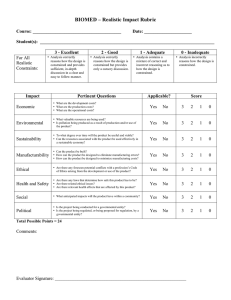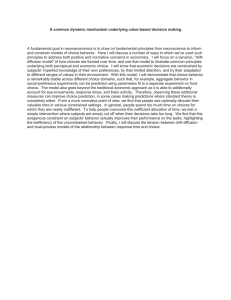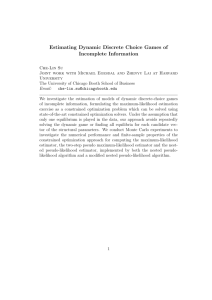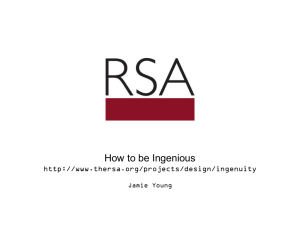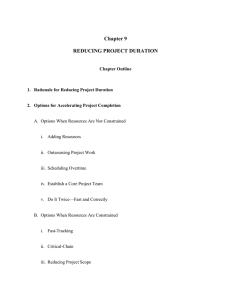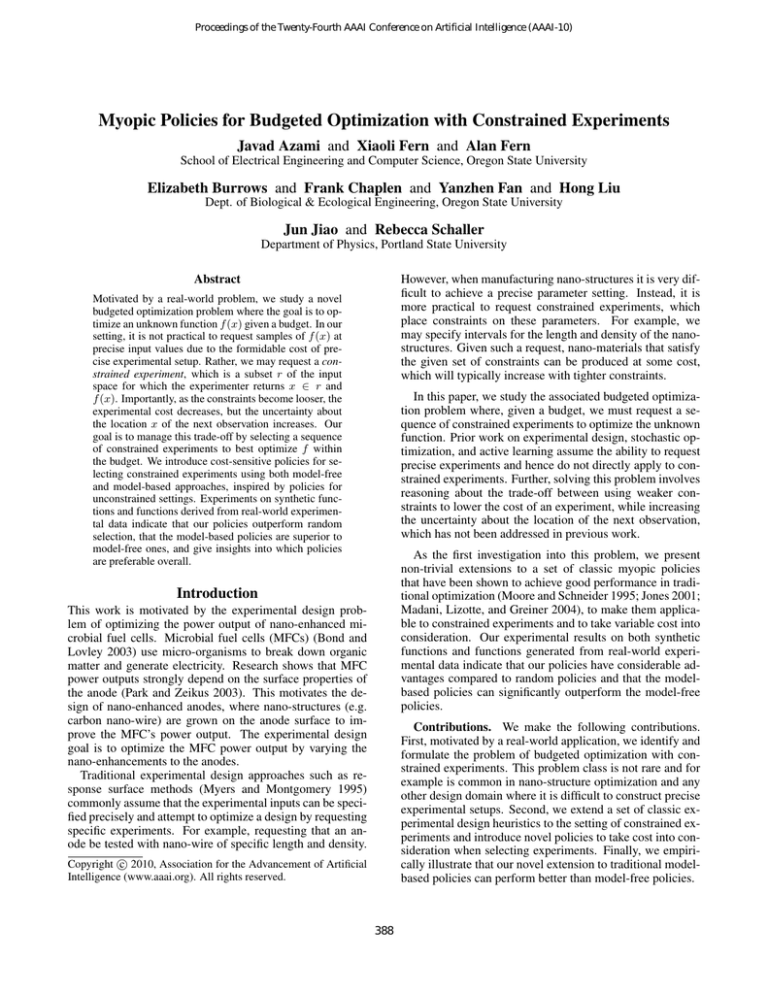
Proceedings of the Twenty-Fourth AAAI Conference on Artificial Intelligence (AAAI-10)
Myopic Policies for Budgeted Optimization with Constrained Experiments
Javad Azami and Xiaoli Fern and Alan Fern
School of Electrical Engineering and Computer Science, Oregon State University
Elizabeth Burrows and Frank Chaplen and Yanzhen Fan and Hong Liu
Dept. of Biological & Ecological Engineering, Oregon State University
Jun Jiao and Rebecca Schaller
Department of Physics, Portland State University
Abstract
However, when manufacturing nano-structures it is very difficult to achieve a precise parameter setting. Instead, it is
more practical to request constrained experiments, which
place constraints on these parameters. For example, we
may specify intervals for the length and density of the nanostructures. Given such a request, nano-materials that satisfy
the given set of constraints can be produced at some cost,
which will typically increase with tighter constraints.
Motivated by a real-world problem, we study a novel
budgeted optimization problem where the goal is to optimize an unknown function f (x) given a budget. In our
setting, it is not practical to request samples of f (x) at
precise input values due to the formidable cost of precise experimental setup. Rather, we may request a constrained experiment, which is a subset r of the input
space for which the experimenter returns x ∈ r and
f (x). Importantly, as the constraints become looser, the
experimental cost decreases, but the uncertainty about
the location x of the next observation increases. Our
goal is to manage this trade-off by selecting a sequence
of constrained experiments to best optimize f within
the budget. We introduce cost-sensitive policies for selecting constrained experiments using both model-free
and model-based approaches, inspired by policies for
unconstrained settings. Experiments on synthetic functions and functions derived from real-world experimental data indicate that our policies outperform random
selection, that the model-based policies are superior to
model-free ones, and give insights into which policies
are preferable overall.
In this paper, we study the associated budgeted optimization problem where, given a budget, we must request a sequence of constrained experiments to optimize the unknown
function. Prior work on experimental design, stochastic optimization, and active learning assume the ability to request
precise experiments and hence do not directly apply to constrained experiments. Further, solving this problem involves
reasoning about the trade-off between using weaker constraints to lower the cost of an experiment, while increasing
the uncertainty about the location of the next observation,
which has not been addressed in previous work.
As the first investigation into this problem, we present
non-trivial extensions to a set of classic myopic policies
that have been shown to achieve good performance in traditional optimization (Moore and Schneider 1995; Jones 2001;
Madani, Lizotte, and Greiner 2004), to make them applicable to constrained experiments and to take variable cost into
consideration. Our experimental results on both synthetic
functions and functions generated from real-world experimental data indicate that our policies have considerable advantages compared to random policies and that the modelbased policies can significantly outperform the model-free
policies.
Introduction
This work is motivated by the experimental design problem of optimizing the power output of nano-enhanced microbial fuel cells. Microbial fuel cells (MFCs) (Bond and
Lovley 2003) use micro-organisms to break down organic
matter and generate electricity. Research shows that MFC
power outputs strongly depend on the surface properties of
the anode (Park and Zeikus 2003). This motivates the design of nano-enhanced anodes, where nano-structures (e.g.
carbon nano-wire) are grown on the anode surface to improve the MFC’s power output. The experimental design
goal is to optimize the MFC power output by varying the
nano-enhancements to the anodes.
Traditional experimental design approaches such as response surface methods (Myers and Montgomery 1995)
commonly assume that the experimental inputs can be specified precisely and attempt to optimize a design by requesting
specific experiments. For example, requesting that an anode be tested with nano-wire of specific length and density.
Contributions. We make the following contributions.
First, motivated by a real-world application, we identify and
formulate the problem of budgeted optimization with constrained experiments. This problem class is not rare and for
example is common in nano-structure optimization and any
other design domain where it is difficult to construct precise
experimental setups. Second, we extend a set of classic experimental design heuristics to the setting of constrained experiments and introduce novel policies to take cost into consideration when selecting experiments. Finally, we empirically illustrate that our novel extension to traditional modelbased policies can perform better than model-free policies.
c 2010, Association for the Advancement of Artificial
Copyright Intelligence (www.aaai.org). All rights reserved.
388
Problem Setup
Second, such policies do not account for variable experimental cost, and assume that each experiment has uniform
cost. Indeed all of the experimental evaluations in (Moore
and Schneider 1995; Lizotte, Madani, and Greiner 2003;
Madani, Lizotte, and Greiner 2004), to name just a few, involve uniform cost experiments.
Let X ⊆ Rn be an n-dimensional input space, where each
element of X is an experiment. We assume an unknown realvalued function f : X → R, which represents the expected
value of the dependent variable after running an experiment.
In our motivating domain, f (x) is the expected power output
produced by a particular nano-structure x. Conducting an
experiment x produces a noisy outcome y = f (x)+, where
is a noise term.
Traditional optimization aims to find an x that approximately optimizes f by requesting a sequence of experiments
and observing their outcomes. In this paper, we request
constrained experiments, which specify the constraints that
define a subset of experiments in X . Specifically, a constrained experiment is defined by a hyper-rectangles r =
hr1 , . . . , rn i, where the ri are non-empty intervals along input dimension i. Given a constrained experiment request r,
the experimenter will return a tuple (x, y, c), where x is an
experiment in r, y is the noisy outcome of x, and c is the cost
incurred. The units of cost will vary across applications. In
our motivating application, costs are dominated by the time
required to construct an experiment satisfying r.
The inputs to our problem include a budget B, a conditional density pc (c|r) over the cost c of fulfilling a constrained experiment r, and a conditional density px (x|r)
over the specific experiment x generated for a constrained
experiment r. Given the inputs, we then request a sequence
of constrained experiments whose total cost is within the
budget. This results in a sequence of m experiment tuples (x1 , y1 , c1 ), . . . , (xm , ym , cm ) corresponding to those
requests that were filled before going over the budget. After the sequence of requests we must then output an x̂ ∈
{x1 , . . . , xm }, which is our prediction of which observed
experiment has the best value of f . This formulation
matches the objective of our motivating application to produce a good nano-structure x̂ using the given budget, rather
than to make a prediction of what nano-structure might be
good. In this paper we assume that pc and px are part of the
problem inputs and use simple forms for these. In general,
these functions can be more complicated and learned from
experience and/or elicited from scientists.
Myopic Policies
Drawing on existing work in traditional optimization
(Moore and Schneider 1995; Jones 2001; Madani, Lizotte,
and Greiner 2004), we extend existing myopic policies to
our setting of constrained experiments. We consider both
model-free policies that do not use predictive models of data,
and model-based policies that use statistical data models.
Model-Free Policies.
Our model-free policies, round robin (RR) and biased round
robin (BRR), are motivated by previous work on budgeted
multi-armed bandit problems (Madani, Lizotte, and Greiner
2004). In the multi-armed bandit setting the RR policy seeks
to keep the number of pulls for each arm as uniform as possible. Here we apply the same principle to keep the experiments as uniformly distributed as possible. Given an experimental state (D, B), where D is the current set of observed
experiments and B is the remaining budget, RR returns the
largest hyper-rectangle r (i.e., with the least cost) that does
not contain any previous experiment in D. If the expected
cost of r exceeds budget B, we return the constrained experiment with expected cost B that contains the fewest experiments in D. Ties are broken randomly.
The BRR policy is identical to RR except that it repeats
the previously selected r as long as it results in an outcome
that improves over the current best outcome in D and has
expected cost less than B. Otherwise, RR is followed. This
policy is analogous to BRR for multi-armed bandit problems
where an arm is pulled as long as it has a positive outcome.
Model-Based Policies.
For model-based policies, we learn a posterior distribution
p(y|x, D) over the outcome y of each individual experiment
x from the current set of observed experiments D. Existing model-based policies for traditional experimental design typically select the experiment x that maximizes certain heuristics computed from statistics of the posterior (e.g.
the mean or the upper confidence interval of y, see (Jones
2001)). The heuristics provide different mechanisms for
trading-off exploration (probing unexplored regions) and exploitation (probing areas that appear promising given D).
However, since they are defined for precise experiments they
are not directly applicable to constrained experiments.
To define analogous heuristics for constrained experiments, we note that it is possible to use p(y|x, D) to define a
posterior distribution p̄ over the outcome of any constrained
experiment. In particular, for a constrained experiment r,
we have p̄(y|r, D) , EX|r [p(y|X, D)] where X ∼ px (·|r).
This definition corresponds to the process of drawing an experiment x from r and then drawing an outcome for x from
p(y|x, D). p̄ effectively allows us to treat constrained experiments as if they were individual experiments in a traditional optimization problem. Thus, we can define heuristics
Related Work
This work is related to active learning, which focuses on
requesting training examples to improve learning efficiency
(Cohn et al. 1996). To our knowledge all such algorithms request specific training examples and are thus not applicable
to our setting. Also, our objective of function optimization is
quite different. Our work is more closely related to stochastic optimization and experimental design (Myers and Montgomery 1995), where many myopic policies have been developed (Moore and Schneider 1995; Lizotte, Madani, and
Greiner 2003; Madani, Lizotte, and Greiner 2004). Given
the current set of experiments D, these policies leverage statistical models of the data to select the next unconstrained
experiment. There are two reasons that these existing policies cannot be directly applied here. First, they operate on
individual experiments rather than constrained experiments.
389
the least cost constrained experiment that both 1) “approximately optimizes” the heuristic value, and 2) its expected
improvement is no worse than spending the same amount of
budget on a set of random experiments. The first condition
encourages constrained experiments that look good according to the heuristic. The second condition helps to set a limit
on the cost we are willing to pay to achieve a good heuristic
value. In particular, we will only be willing to pay a cost of
c for a single constrained experiment r if the expected improvement achieved by r is at least as good as the expected
improvement achieved by a set of random experiments with
total cost c. Note that the second condition can always be
satisfied since a random experiment is equivalent to a constrained experiment of the least possible cost.
To formalize this policy we first define “approximately
optimize” more precisely by introducing a parameterized
version of the CMC policy and then showing how the parameter will be automatically selected via condition 2. For a
given heuristic H, let h∗ be the value of the highest scoring
constrained experiment. For a given parameter α ∈ [0, 1],
the CMCH,α policy selects the least-cost constrained experiment that achieves a heuristic value of at least α · h∗ . Formally, this is defined as:
for constrained experiments by computing the same statistics of the posterior p̄, as used in traditional optimization. In
this work we consider four such heuristics.
Definition of Heuristics. The maximum mean (MM)
heuristic computes the expected outcome according to the
current posterior p̄. That is, MM(r|D) = E[y|r, D] for
y ∼ p̄(·|r, D). MM is purely exploitive, which has been
shown to be overly greedy and prone to getting stuck in poor
local optima (Moore and Schneider 1995).
The maximum upper interval (MUI) heuristic attempts
to overcome the greedy nature of MM by exploring areas
with non-trivial probability of achieving a good result as
measured by the upper bound of the 95% confidence interval of y. The MUI heuristic for constrained experiments
MUI(r|D) is equal to the upper bound of the 95% confidence interval of the current posterior p̄(y|r, D). Initially,
MUI will aggressively explore untouched regions of the experimental space since y in such regions will have high posterior variance. As experimentation continues and uncertainty decreases, MUI will focus on the most promising areas and behave like MM.
The maximum probability of improvement (MPI) heuristic
computes the probability of generating an outcome y that
improves on the current best outcome y ∗ in D. The basic
MPI only considers the probability of improvement and does
not consider the amount of improvement. This deficiency
is addressed by using a margin m with MPI, which we will
refer to as MPI(m). Let y ∗ be the current best outcome in D,
then MPIm (r|D) is equal to the probability that the outcome
of constrained experiment r will be greater than (1 + m)y ∗ .
Increasing the margin m causes the heuristic to change its
behavior from exploitive to explorative.
The maximum expected improvement (MEI) heuristic
aims to improve on basic MPI without requiring a margin
parameter. Specifically, it considers the expected value of
improvement according to the current posterior. In particularly let I(y, y ∗ ) = max{y − y ∗ , 0}, the MEI heuristic is
defined as MEI(r|D) = E[I(y, y ∗ )|r] for y ∼ p̄(y|r, D).
Note that these heuristics do not take the variable cost into
account. If we assume that the cost of a constrained experiment r monotonically decreases with the size of its region
of support, which is the most natural case to consider, it is
easy to show that for all of our heuristics, the value of a
constrained experiment r is monotonically non-decreasing
with respect to the cost of r. If a heuristic does not take the
variable cost into account, it will select the constraint experiments that are maximally constraint and centered around the
individual experiment maximizing the heuristics. Therefore,
it might consume more budget than is warranted. This shows
that there is a fundamental trade-off between the heuristic
value and cost of constrained experiments that we must address. Below we introduce two novel cost-sensitive policies
to address this tradeoff.
CMCH,α (D, B) = arg min{c(r) : H(r|D) ≥ αh∗ , c(r) ≤ B}
r∈R
where c(r) is the expected cost of r.
The value of α controls the trade off between the cost of r
and its heuristic value. When α is close to one then CMCH,α
must choose constrained experiments that are close to the
maximum heuristic value, which will be costly. Rather,
when α is small, it will choose lower cost constrained experiments with lower heuristic values, which increases the
uncertainty about the individual experiment that will be observed, providing some constrained exploration.
In preliminary work, we experimented with the CMCH,α
policy and found that it was difficult to select a value of α
that worked well across a wide range of optimization problems, cost structures, and budgets. In particular, when α is
too small the effect of the heuristic guidance is minimized
and when it is too large, the policy would often choose extremely costly constrained experiments, leaving little budget
for the future. This motivated the introduction of the condition 2 above to help adaptively select an appropriate α at
each call of the policy.
In particular, we select the largest value of α such that the
experiment suggested by CMCH,α satisfies condition 2. To
formalize this, let rα be the constrained experiment returned
by CMCH,α . Let EIR(D, C) be the expected improvement
(as defined for the MEI policy above) of selecting random
experiments that total a cost of C, and c(rα ) be the expected
cost of rα . Our parameter-free CMC policy is defined as:
CMCH (D, B) = CMCH,α∗ (D, B)
α∗ = max{α ∈ [0, 1] : MEI(rα |D) ≥ EIR(D, c(rα ))}
In practice we compute EIR(D, C) via Monte Carlo simulation and α∗ via a discretized line search. We provide further details on implementations in the next section. In our
experiments, we have observed that this approach for setting
α is robust across different problems and heuristics.
Constrained Minimum Cost (CMC) Policies. For any
heuristic on constrained experiments H(r|D), which assigns a score to constrained experiment r given a set of observed experiments D, we can define an associated CMC
policy. Informally, the principle behind CMC is to select
390
Cost Normalized MEI (CN-MEI). Here we define an
alternative parameter-free policy, which selects the constrained experiment achieving the highest expected improvement per unit cost. In particular, the policy is defined as:
CN-MEI(D, B) = arg max
r∈R
Table 1: Benchmark Functions
Cosines
Rosenbrock
Discont
MEI(r|D)
: c(r) ≤ B .
c(r)
In concept we could define CN policies for heuristics other
than MEI. To limit our scope we choose to consider only
MEI due to it nice interpretation as a rate of improvement.
This principle of normalizing an improvement measure
by cost is a natural baseline and has been suggested in the
context of other optimization problems. However, in most
prior work the actual empirical evaluations involved uniform
cost models and thus there is little empirical data regarding
the performance of normalization. Thus, our empirical evaluation necessarily provides a substantial evaluation of this
normalization principle.
1 − (u2 + v 2 − 0.3cos(3πu) − 0.3cos(3πv))
u = 1.6x − 0.5, v = 1.6y − 0.5
10 − 100(y − x2 )2 − (1 − x)2
1 − 2((x − 0.5)2 + (y − 0.5)2 ) if x < 0.5
0 otherwise
Test Functions
We evaluate our policies using five functions over [0, 1]2 .
The first three functions: Cosines, Rosenbrock, and Discontinuous (listed in Table 1) are benchmarks widely used
in previous work on stochastic optimization (Brunato, Battiti, and Pasupuleti 2006). Here we use a zero-mean Gaussian noise model with variance equal to 1% of the function
range. Exploratory experiments with larger noise levels indicate similar qualitative performance, though absolute optimization performance of the methods degrades as expected.
The other two functions are derived from real-world
experimental data involving hydrogen production and our
MFC application. For the former data was collected in
a study on biosolar hydrogen production (Burrows et al.
2009), whose goal was to maximize the hydrogen production of the cyanobacteria Synechocystis sp. PCC 6803 by
optimizing the growth media’s pH and Nitrogen levels. The
data set contains 66 samples uniformly distributed over the
2D input space. This data is used to simulate the true function by fitting a GP to it, picking kernel parameters via standard validation techniques. We then simulated the experimental design process by sampling from the posterior of this
GP to obtain noisy outcomes for requested experiments.
For the MFC application, we utilize data from some initial MFC experiments using anodes coated with gold nanoparticles under different fabrication conditions. The construction of each anode is costly and requires approximately
two days. Each anode was installed in an MFC whose current density was recorded at regular intervals. The temporally averaged current density is taken to be the dependent
variable to be optimized by modifying two features of the
nano-structure on each anode: average area of individual
particles, and average circularity of individual particles. We
select these features because they can be roughly controlled
during the fabrication process and appear to influence the
current density. Due to the high cost of these experiments,
our data set currently contains just 16 data points, which are
relatively uniformly distributed over the experimental space.
Considering the sparsity we choose polynomial Bayesian regression to simulate the true function, using standard validation techniques to select model complexity. The simulated
function is then visually confirmed by our collaborator.
Implementation Details
To compute the conditional posterior p(y|x, D) required by
our model-based heuristics, we use Gaussian process regression with a zero mean prior and a covariance specified by a
1
Gaussian Kernel K(x, x0 ) = σ exp − 2l
|x − x0 |2 , with ker2
, where
nel width l = 0.02 and signal variance σ = ymax
ymax is an upper bound on the outcome value.We did not
optimize these parameters, but did empirically verify that
the GPs behaved reasonably for our test functions.
Given p(y|x, D) we need to compute the various heuristics defined in the previous section, which were defined over
p̄(y|r, D) and need to be computed via integration over the
region of a constrained experiment r. Because these integrals do not have closed forms, we approximate the integrals
by discretizing the space of experiments and using summation in place of integration. In our experiments we used a
discretization level of 0.01 (1/100 of the input range).
This implementation is most appropriate for low dimensional optimization. For higher dimensional applications,
one can use Monte Carlo sampling to estimate all of the expectations, the complexity of which can be independent of
the dimension, and use empirical gradient descent with random restarts to find an optimizing constrained experiment.
Experimental Results
Our goal is to evaluate the performance of the proposed policies in scenarios that resemble typical real-world scientific
applications. In particular, we focus on low-dimensional
optimization problems for two reasons. First, with typical
budgets the number of total experiments is often limited,
which makes optimizing over many dimensions impractical.
Thus, the scientists typically select only a few key dimensions to consider. Second, in real-world applications, such
as our motivating problem, it is prohibitively difficult to satisfy constraints on more than a couple of experimental variables. Thus, the most relevant scenarios for us and many
other problems are moderate numbers of experiments and
small dimensionality.
Modeling Assumptions
Our experiments assume that the density Px (x|r) over experiments given a request r is uniform over r. We further
assume that the density Pc (c|r) over the cost given a request
is a Gaussian distribution, with a standard deviation
of 0.01
Pn
and a mean equal to 1 + slope
,
where
l(r)
=
|r
| meai
i=1
l(r)
sures the size of the constrained experiment r. In this setup,
each experiment requires at least one unit cost, with the ex-
391
pected additional cost being inversely proportional to the
size of the constrained experiment r. The value of slope dictates how fast the cost increases as the size of a constrained
experiment decreases. This cost model in inspired by the
fact that all experimental setups require a minimal amount of
work, here unit cost, but that the amount of additional work
grows with increased constraints given to the experimenter.
All of our policies easily extend to other cost models.
Table 2: Normalized regrets.
slope = 0.1
Results
Given a budget and function f to be optimized, each policy
run results in a set of observed experiments D. Let x̂ be
the experiment in D that is predicted to have the maximum
expected outcome. The regret of the policy for a particular
run is defined to be y ∗ − f (x̂), where y ∗ is the maximum
value of f . For each test function and choice of budget and
cost structure (i.e. choice of slope), we evaluate each policy
by averaging the regret over 200 runs. Each run starts with
five randomly selected initial points and then policies are
used to select constrained experiments until the budget runs
out, at which point the regret is measured. To compare the
regret values across different functions we report normalized
regret values, which are computed by dividing the regret of
each policy by the mean regret achieved by a random policy
(i.e., a policy always selecting the entire input space). A
normalized regret less than one indicates that an approach
outperforms random, while a value greater than one suggests
it is worse than random.
In our first set of experiments we fix the budget to be 15
units and consider the effect of varying the cost-model slope
parameter over values 0.1, 0.15, and 0.3.
For the MPI heuristic we set the margin m = 0.2, which
based on a small number of trials performed well compared
to other values. Table 2 shows the results for individual functions, giving both the average normalized regrets over 200
trials and the standard deviations. To assess the overall performance, it also gives the normalized regrets for each policy
averaged across our five functions at the bottom of the table.
Below we review our main empirical findings.
Model-Free Policies. The overall average performance of
RR and BRR, as shown in Table 2, improves over random
by approximately 10% across different slopes. This shows
that the heuristic of evenly covering the space pays off compared to random. BRR is observed to perform slightly better
than RR, suggesting that the additional exploitive behavior
of BRR pays off overall. Looking at the individual results,
however, we see that for hydrogen and fuel-cell both BRR
and RR perform worse than random. Further investigation
reveals that this poor performance is because RR/BRR have
a bias toward experiments near the center of the input space,
and the hydrogen and fuel-cell functions have their optimal
points near corners of the space. This bias is because constrained experiments (rectangles) are required to fall completely within the experimental space of [0, 1]2 and there are
fewer such rectangles that contain points near the edges and
corners.
cn-MEI
cmc-MEI
cmc-MPI(0.2)
cmc-MUI
cmc-MM
RR/BRR
0.569 (.34)
0.417 (.28)
0.535 (.39)
0.797 (.40)
0.708 (.48)
0.842 / 0.833
(.40/.40)
cn-MEI
cmc-MEI
cmc-MPI(0.2)
cmc-MUI
cmc-MM
RR/BRR
0.527(.44)
0.564(.42)
0.954(.82)
0.710(.69)
1.289(1.1)
0.602/0.587
(.51/.50)
cn-MEI
cmc-MEI
cmc-MPI(0.2)
cmc-MUI
cmc-MM
RR/BRR
0.602(.40)
0.547(.35)
0.503(.36)
0.805(.79)
0.721(.68)
0.897/0.881
(.85/.83)
cn-MEI
cmc-MEI
cmc-MPI(0.2)
cmc-MUI
cmc-MM
RR/BRR
0.176(.26)
0.129(.26)
0.408(.63)
0.716(.60)
0.728(.80)
1.107/ 1.065
(.68/.68)
cn-MEI
cmc-MEI
cmc-MPI(0.2)
cmc-MUI
cmc-MM
RR/BRR
0.929(.15)
0.931(.11)
0.932(.16)
0.971(.19)
0.945(.22)
1.038/1.029
(.21/.20)
cn-MEI
cmc-MEI
cmc-MPI(0.2)
cmc-MUI
cmc-MM
RR/BRR
slope = 0.1
0.560
0.517
0.666
0.800
0.874
0.897 / 0.879
slope = 0.15
Cosines
0.714 (.41)
0.514 (.40)
0.584 (.42)
0.804 (.41)
0.767 (.48)
0.866 / 0.862
(.40/.41)
Discontinuous
0.497(.44)
0.677(.57)
0.940(.74)
0.709(.79)
1.225(1.1)
0.617/0.602
(.53/.53)
Rosenbrock
0.665(.49)
0.556(.39)
0.594(.44)
0.974(.13)
0.740(.73)
0.930/ 0.927
(.87/.90)
Hydrogen
0.354(.46)
0.233(.43)
0.449(.71)
0.695(.61)
0.605(.73)
1.161/1.123
(.69/.70)
Fuel Cell
0.950(.17)
0.908(.14)
0.930(.19)
0.973(.23)
0.963(.32)
1.049/1.044
(.22/.21)
Overall Average
slope = 0.15
0.636
0.578
0.698
0.831
0.889
0.925 / 0.911
slope = 0.30
0.826 (.42)
0.794 (.46)
0.616 (.43)
0.817 (.40)
0.736 (.45)
0.897 / 0.889
(.41/.41)
0.626(.60)
0.779(.65)
0.951(.78)
0.693(.64)
1.116(1.1)
0.634/0.634
(.56/.57)
0.736(.60)
0.630(.47)
0.608(.48)
0.913(1.0)
0.662(.61)
0.967/0.955
(1.0/.98)
0.852(.66)
0.420(.53)
0.613(.73)
0.868(.65)
0.691(.77)
1.173/1.148
(.67/.67)
0.986(.22)
0.940(.16)
0.943(.20)
0.995(.21)
0.963(.33)
1.046/1.041
(.22/.22)
slope = 0.30
0.805
0.712
0.746
0.857
0.834
0.944 / 0.934
we see that all model-based policies outperform random,
with the exception of CMC-MM on the Discontinuous function. This shows that our two approaches (CMC and CN)
for considering cost in our policies are able to make sensible
choices and avoid expending the budget more quickly than is
warranted. In addition, the averaged overall results suggest
that all model-based approaches outperform the model-free
approaches. This indicates that the heuristics we are considering and our GP regression model are providing useful information for guiding the constrained experiment selection.
Model-Based Policies. We first observe from the averaged
overall results that the model-based policies perform better
than random. Looking at the results on individual functions,
392
Cosines
Rosen
Hydrogen
Fuel Cell
Figure 1: Regret (unnormalized) vs. Cost curves for 4 proposed functions at slope=0.1.
budgeted optimization problem with constrained experiments; 2) we extended a number of classic experimental
design heuristics to the case of constrained experiments; 3)
we introduced novel strategies (CMC and CN) to take cost
into consideration in selecting constrained experiments; 4)
we empirically evaluated the proposed heuristics and costsensitive policies. Our results demonstrate that the proposed
cost-sensitive policies significantly outperform both random
selection as well as the model-free policies. Overall we
found that the CMC-MEI policy demonstrated robust performance and is parameter-free, making it a recommended
method. For future work, we plan to investigate non-myopic
policies (e.g., monte-carlo planning techniques) and richer
cost and action models that more closely match the needs of
real budgeted optimization applications.
Comparing different heuristics, we see that the MEIbased methods are the top contenders among all methods.
Looking at the individual results, we can see that this holds
for all functions except for Rosenbrock, where the CMCMPI is slightly better than MEI-based methods. A closer
look into the MPI and MEI heuristics reveals that MPI tends
to select slightly fewer experiments than MEI, which we
conjecture is because the MEI heuristic tends to be smoother
than MPI over the experimental space. Based on these observations and the fact that it does not require selecting a
margin parameter, we consider MEI as the most preferable
heuristic to use.
Next, we compare the two different strategies for dealing with cost, i.e., CMC and CN. Specifically, we compare
CMC-MEI with CN-MEI and observe that CMC-MEI outperforms CN-MEI for all but the Discontinuous function.
When examining the behaviors of these two policies, we
observed that CMC-MEI tends to be more conservative regarding the cost it selects early on in the budget, choosing
constrained experiments that were closer to random. This
behavior is desirable since exploration is the primary issue
when few experiments have been performed and random is
a reasonably good and very cheap exploration policy.
References
Bond, D., and Lovley, D. 2003. Electricity production by geobacter
sulfurreducens attached to electrodes. Applications of Environmental Microbiology 69:1548–1555.
Brunato, M.; Battiti, R.; and Pasupuleti, S. 2006. A memorybased rash optimizer. In AAAI-06 Workshop on Heuristic Search,
Memory Based Heuristics and Their applications.
Burrows, E. H.; Wong, W.-K.; Fern, X.; Chaplen, F. W.; and Ely,
R. L. 2009. Optimization of ph and nitrogen for enhanced hydrogen production by synechocystis sp. pcc 6803 via statistical and
machine learning methods. Biotechnology Progress 25(4):1009–
1017.
Cohn, D.; ; Ghahramani, Z.; and Jordan, M. 1996. Active learning
with statistical models. Journal of Artificial Intelligence Research
4:129–145.
Jones, D. 2001. A taxonomy of global optimization methods based
on response surfaces. Journal of Global Optimization 21:345–383.
Lizotte, D.; Madani, O.; and Greiner, R. 2003. Budgeted learning
of naive-bayes classifiers. In UAI.
Madani, O.; Lizotte, D.; and Greiner, R. 2004. Active model
selection. In UAI.
Moore, A., and Schneider, J. 1995. Memory-based stochastic optimization. In NIPS.
Myers, R., and Montgomery, D. 1995. Response surface methodology: process and product optimization using designed experiments.
Wiley.
Park, D., and Zeikus, J. 2003. Improved fuel cell and electrode designs for producing electricity from microbial degradation.
Biotechnol.Bioeng. 81(3):348–355.
Rasmussen, C. E., and Williams, C. K. I. 2006. Gaussian Processes
for Machine Learning. MIT.
Varying Budgets. In the last set of experiments, we fixed
the cost model slope to 0.1 and varied the budget from 10
to 60 units in increments of 10. The goal is to observe the
relative advantage of the model-based policies compared to
random as the budget increases. In addition, we want to see
how the model-based policies work and what is the difference among them given larger budgets.
Figure 1 plots the absolute regret (unnormalized) versus
cost for our model based policies on four test functions. As
the main observation, we see that policies based on MEI and
MPI maintain a significant advantage over random across a
wide range of budgets. The CMC-MEI and CMC-MPI policies are roughly comparable for all functions except for the
fuel cell function. In that case CMC-MPI slightly outperforms CMC-MEI for large budgets.
Overall, given the results from the previous experiment, CMC-MEI can still be considered as a recommended
method, due to its combination of good performance, robustness and the fact that it is parameter-free.
Conclusion
This paper makes the following key contributions: 1) Motivated by a real-world application we formulated the novel
393


